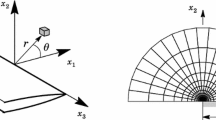Abstract
A toughness correction method, developed as ISO 27306, specifies an equivalent crack tip opening displacement (CTOD) ratio, β, for the correction of CTOD toughness for constraint loss in structural components. Using β, the standard fracture toughness specimen and structural components are linked at the same level of the Weibull stress. This paper applies the IST method to the fracture assessment of welded components. Effects of the strength mismatch and residual stress in welds on β are implemented into the toughness correction. The strength mismatch does not have an influence on β, provided that the strength mismatch between the weld and base metals is in the range from 0.9 to 1.2. On the other hand, residual stress exerts a large influence at a low CTOD level below full yielding: β is elevated by the tensile residual stress. It is shown on the failure assessment diagram that the CTOD toughness correction with β eliminates the excessive conservatism often found in the conventional approach and leads to accurate fracture assessments of welded components.
















Similar content being viewed by others
Notes
IST is the abbreviation for a national project in Japan, International Standardization of Fracture Toughness Evaluation Procedure for Fracture Assessment of Steel Structure, completed in 2005 with a financial support from the Ministry of Economy, Trade and Industry (METI).
References
FITNET (2008) European Fitness-for-Service (FFS) Procedure, MK 8, vols. 1 and 2. GKSS Research Center
Minami F, Ohata M, Shimanuki H, Handa T, Igi S, Kurihara M, Kawabata T, Yamashita Y, Tagawa T, Hagihara Y (2006) Method of constraint loss correction of CTOD fracture toughness for fracture assessment of steel components. Eng Fract Mech 73:1996–2020
ISO 27306-2009(E): Metallic materials—method of constraint loss correction of CTOD fracture toughness for fracture assessment of steel components
Beremin F (1983) A local criterion for cleavage fracture of a nuclear pressure vessel. Metall Trans A 14a:2277–2287
Cicero S, Ainsworth RA, Gutiérrez-Solana F (2010) Engineering approaches for assessment of low constraint fracture conditions: a critical review. Eng Fract Mech 77:1360–1374
Minami F, Ohata M (2012) Constraint assessment of brittle fracture of steel components, ISO 27306 vs FITNET FFS. Eng Fract Mech 84:67–82
Minami F, Katou T, Nakamura T, Arimochi K (1999) Equivalent CTOD concept for fracture toughness requirement of materials for steel structures. Proceedings of the 18th International Conference on Offshore Mechanics and Arctic Engineering, OMAE99/MAT-2130, St. John’s, Newfoundland, Canada
BSI, BS7448 Part 1—1991: Fracture mechanics toughness tests. Method for determination of K Ic, critical CTOD and critical J values of metallic materials
ISO 12135-2002(E): Metallic materials—unified method of test of the determination of quasistatic fracture toughness
Minami F, Arimochi K (2004) Constraint correction of fracture toughness CTOD for fracture performance evaluation of structural components. Journal of ASTM International, vol. 1, Paper ID JAI10615
Harrison JD (1980) The state-of-the-art in crack tip opening displacement (CTOD) testing and analysis, part 1—background and testing methods. Metal Constr 12:415–422
Minami F, Takashima Y, Ohata M (2011) Constraint-based assessment of CTOD toughness requirement for high-strain line pipe. Int J Offshore Polar Eng 21:129–140
Minami F, Ohata M, Manabe T, Chiba Y, Murayama K (2009) Significance of strength mismatch in fracture performance evaluation of welded joints—characterization of mismatch effect by the Weibull stress criterion. Weld World 53(5/6):140–150
Yamashita Y, Minami F (2010) Constraint loss correction for assessment of CTOD fracture toughness under welding residual stress, part I: methodology using the equivalent CTOD ratio. Eng Fract Mech 77:2213–2232
Gunnert R (1962) Measuring of residual stresses and strains. IIW Doc. X-288-62
Bilby BA, Cottrell AH, Smith E, Swinden KH (1963) The spread of plastic yield from a notch. Proc R Soc Lond A272:304–314
BSI, BS 7910-2005: Guide on methods for assessing the acceptability of flaws in metallic structures
Tada S, Harris PC, Irwin GR (2000) The stress analysis of cracks handbook, 3rd edn. ASME, New York
Minami F, Ohata M, Toyoda M, Tanaka T, Arimochi K, Glover AG, North TH (1995) The effect of weld metal yield strength on the fracture behavior of girth welds in grade 550 pipe. Pipeline Technol 1:441–461
Slatcher S (1986) The estimation of characteristics fracture toughness values. Veritas Research Technical Report
API 579-1/ASME FFS-1: Fitness-for-service, 2007
Japan Welding Engineering Society, WES 2805-2011: method of assessment for flaws in fusion welded joints with respect to brittle fracture and fatigue crack growth
Yamashita Y, Minami F (2010) Constraint loss correction for assessment of CTOD fracture toughness under welding residual stress, part II: application of toughness correction methodology. Eng Fract Mech 77:2419–2430
Larsson SG, Carlsson AJ (1973) Influence of non-singular stress terms and specimen geometry on small-scale yielding at crack tips in elastic–plastic materials. J Mech Phys Solids 21:263–277
Betegón C, Hancock JW (1991) Two-parameter characterization of elastic–plastic crack-tip fields. J Appl Mech 58:104–110
Wang Y-Y (1991) Two-parameter characterization of elastic–plastic crack-tip fields and applications to cleavage fracture. PhD thesis, Department of Mechanical Engineering, Massachusetts Institute of Technology
O’Dowd NP, Shih CF (1991) Family of crack-tip fields characterization by a triaxiality parameter—I. Structure of fields. J Mech Phys Solids 39:989–1015
O’Dowd NP, Shih CF (1992) Family of crack-tip fields characterization by a triaxiality parameter—II. Fracture applications. J Mech Phys Solids 40:939–963
Zhdanov IM, Gonchar AK (1978) Determining the residual stresses at a depth in the metal. Automaticheskaya Svarka 36:26–27
Leggatt RH (1997) Welding residual stresses. ICRS-5, Linkoping, Sweden, pp 12–25
Author information
Authors and Affiliations
Corresponding author
Additional information
Doc. IIW-X-1718-12, recommended for publication by Commission X “Structural Performances of Welded Joints—Fracture Avoidance”
Rights and permissions
About this article
Cite this article
Minami, F., Takashima, Y., Ohata, M. et al. Constraint-based assessment of fracture in welded components. Weld World 57, 707–718 (2013). https://doi.org/10.1007/s40194-013-0070-2
Received:
Accepted:
Published:
Issue Date:
DOI: https://doi.org/10.1007/s40194-013-0070-2




